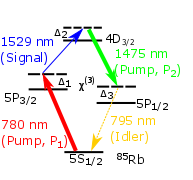Generation of Rb vapor in hollow-core photonic band gap fibers
The nonlinear response of any medium can be enhanced by focusing the light to a high intensity and increasing the length of interaction between the light and the medium. However, owing to the diffractive nature of light, they cannot happen naturally at the same time. The hollow core of photonic band gap fibers is an attractive site for hosting highly nonlinear materials meanwhile guiding the highly focused light for a long distance, dramatically enhancing the nonlinear interactions.

A dense and long lasting Rb vapor in the hollow-core fibers is essential for the applications of our Rb-filled fiber system. We have investigated the time dynamics of light-induced desorption of Rb atoms in hollow-core photonic band gap fibers and have demonstrated all-optical generation of precisely controlled Rb-vapor densities [Phys. Rev. A 79, 063809 (2009)]. In addition, we have demonstrated high optical depths (50±5) that last for hours in Rb-filled fiber system, which represented a 1000× improvement over the operation times compared with the reports by then [Opt. Lett. 40, 5379-5382 (2015)].
Due to the strong geometric localization and non-uniformity of the atoms and the fields, the spectroscopic features of the interactions require reassessment. Our group performed saturable-absorption spectroscopy and passive slow-light experiments to this Rb-filled hollow-core fiber system, revealing large AC Stark shifts, power broadening, and transit-time broadening, that are present even at nanowatt powers [Phys. Rev. A 81, 053825 (2010)].
Ultralow-power four-wave mixing with Rb in hollow-core fibers
Four-wave mixing (FWM) is a nonlinear process by which four electromagnetic field modes can exchange energy. For example, three lasers, each at a different frequency, can produce a fourth laser at a new frequency. Such interactions can be used to generate squeezed light sources, including correlated photon pairs, and unusually high parametric gain. The band-gap fiber architecture allows us to study these effects in a new regime, where weak fields can produce a significant nonlinear effect and strong fields can access new regimes in quantum-optical alkali vapor experiments [Phys. Rev. Lett. 103, 043602 (2009)].

The FWM process sets up a ‘coherence’ in the atomic vapor which can be perturbed using an external optical (switching) field. This perturbation causes a change in the transmission of a signal field participating in the FWM process. Our group has demonstrated all-optical modulation at bandwidths exceeding 300 MHz with a switching energy corresponding to only 23 photons per atomic cross-section [Opt. Lett. 35, 2287-2289 (2010)].
Noise-free frequency translation of optical fields has potential applications in quantum information processing, quantum memories, and high-speed signal processing. Bragg scattering by FWM is a promising way to manipulate the frequency of photonic quantum states without adding noise. Our group showed that by interacting the light with warm Rb vapor confined to a hollow-core fiber, we can achieve 21% conversion efficiency with pump powers of only 300 microwatt. [Opt. Lett. 39, 1557-1560 (2014)]. Furthermore, we have shown that using a similar Bragg scattering configuration, it is possible to convert photons between 1529 nm (telecom) and 795 nm (near-visible), linking low loss transmission band of standard optical fibers to the rubidium quantum memories. This is the largest conversion span reported from a third order nonlinear process [CLEO 2017, JTu5A.32].
Spontaneous FWM in warm Rb vapor is a robust way to generate correlated photon pairs for Rb quantum memory based communication networks. Our group has demonstrated correlated photon generation using a diamond scheme in a warm Rb vapor cell, where pump wavelengths at 780 nm and 776 nm generate correlated photon pairs at 762 and 795 nm. We establish the non-classical nature of the generated photon pairs by showing a large violation of the Cauchy Schwarz inequality [CLEO 2016, FTu1C.7].
Two-photon absorption and all-optical modulation at a few photon level
Two-photon absorption (TPA) is the simultaneous absorption of either two photons from a single beam of light (degenerate) or two single photons from two beams (nondegenerate) and results in a resonant transition from the ground state to an excited state. Many interesting two photon processes and their applications, such as all-optical switching and generation of single photons, require a significant TPA at low power levels. We have demonstrated that TPA in rubidium atoms can be greatly enhanced by the use of a photonic-band-gap fiber. We have demonstrated 1% TPA with only 1mW using a degenerate scheme [Phys. Rev. A 83, 033833 (2011)]. Further using nondegenerate TPA we have demonstrated 25% all-optical modulation with <20 photons, i.e., a few attojoules of energy with a response time <5 ns [Phys. Rev. Lett. 107, 193902 (2011)].
Few-photon cross-phase modulation
The ability of a few-photon light field to impart an appreciable phase shift on another light field is critical for many quantum information applications. A recently proposed paradigm for quantum computation utilizes weak nonlinearities, where a strong field mediates such cross-phase shifts between single photons. Such a protocol promises to be feasible in terms of scalability to many qubits if a cross-phase shift of 10-5 to 10-2 radians per photon can be achieved. Using two-photon absorption in a rubidium filled PBGF we have demonstrated large cross-phase shifts of 0.3 mrad per photon with a fast response time (<5 ns), which represents, to our knowledge, the largest such nonlinear phase shift induced in a single pass through a room temperature medium [Nature Photon. 7, 138-141 (2012)].
Frequency comb generation in the near-visible regime
Silicon based third order parametric processes tend to have lower efficiency in the near-visible regime due to the challenge in dispersion engineering. Our group designed high Q silicon nitride ring resonators with dispersion parameters tailored for higher order modes. We demonstrated these devices can generate broad turning range correlated photon pairs matching varies heavily used atomic transitions. We also showed frequency comb generation spanning 45 THz [CLEO 2017, STu4J.5].
